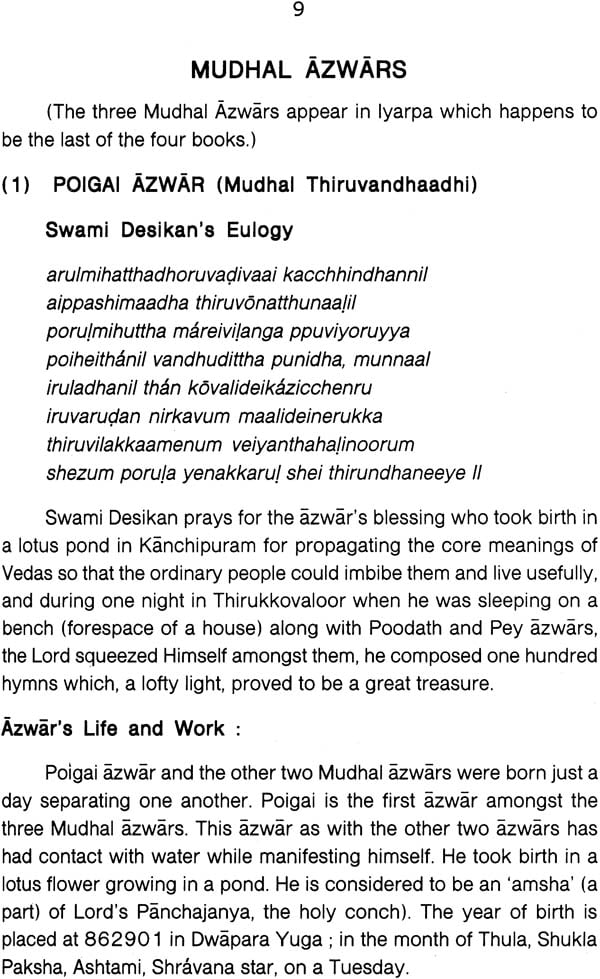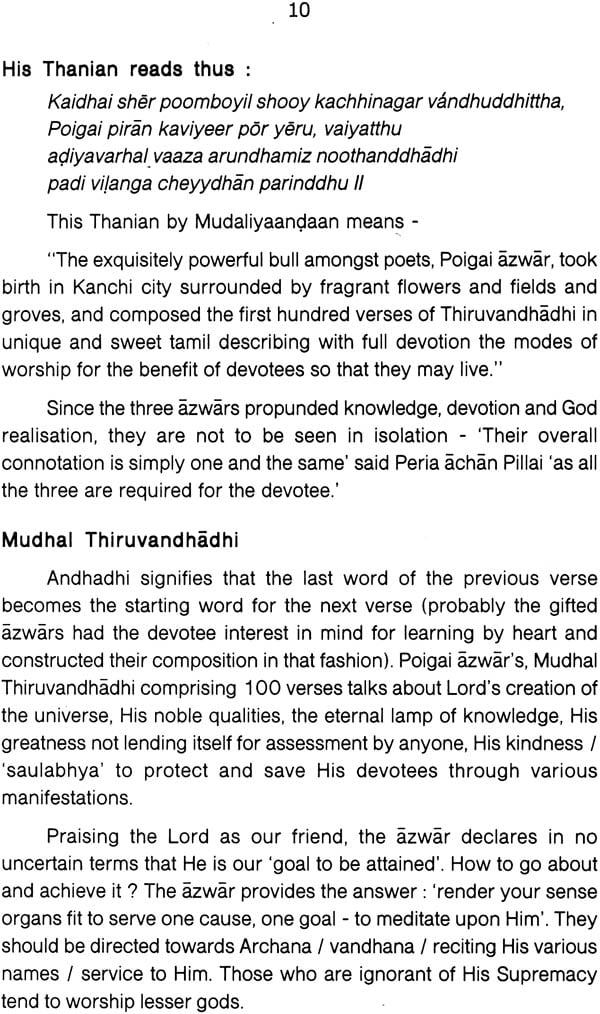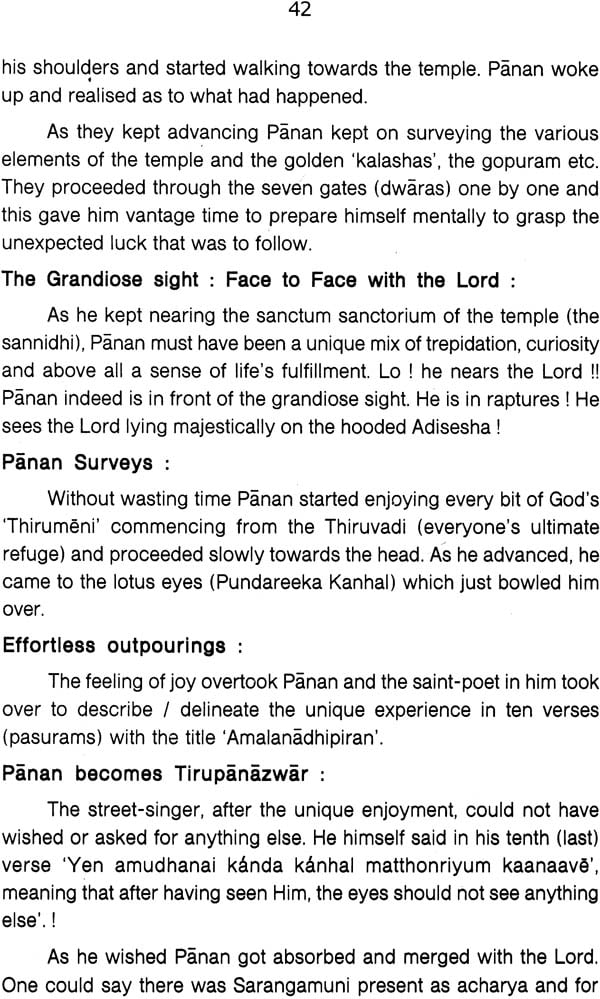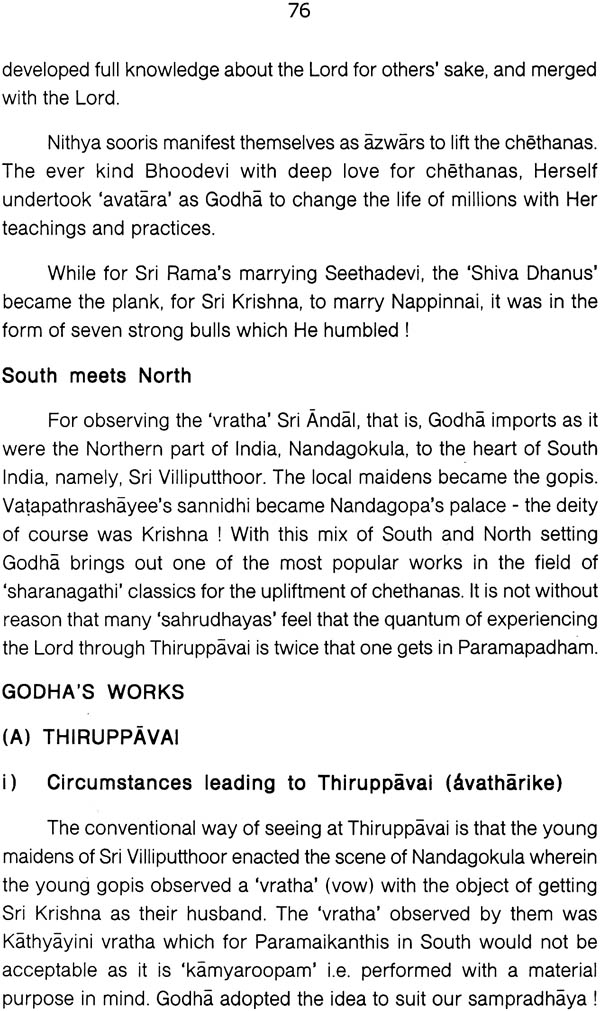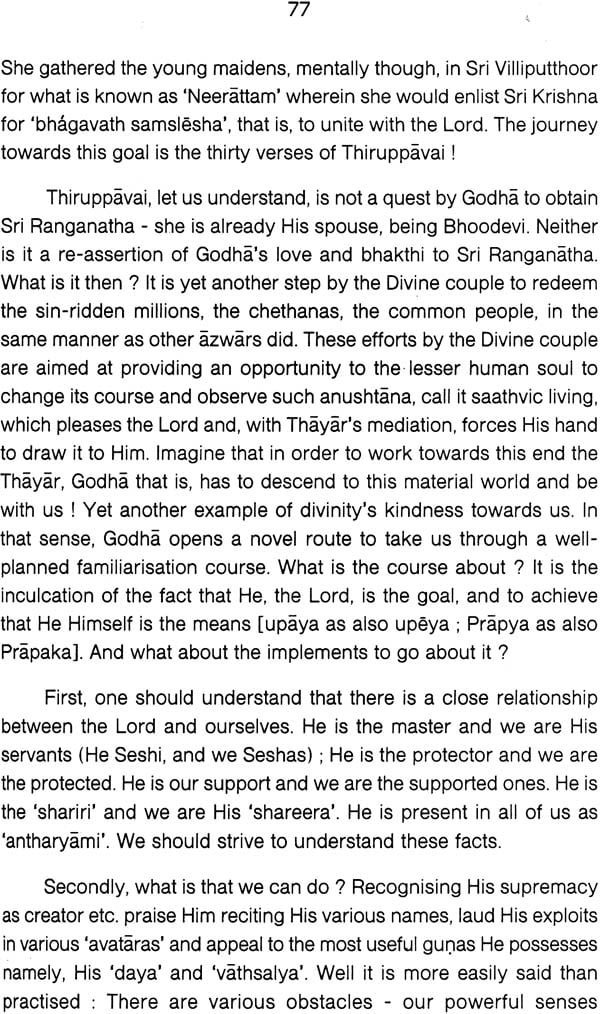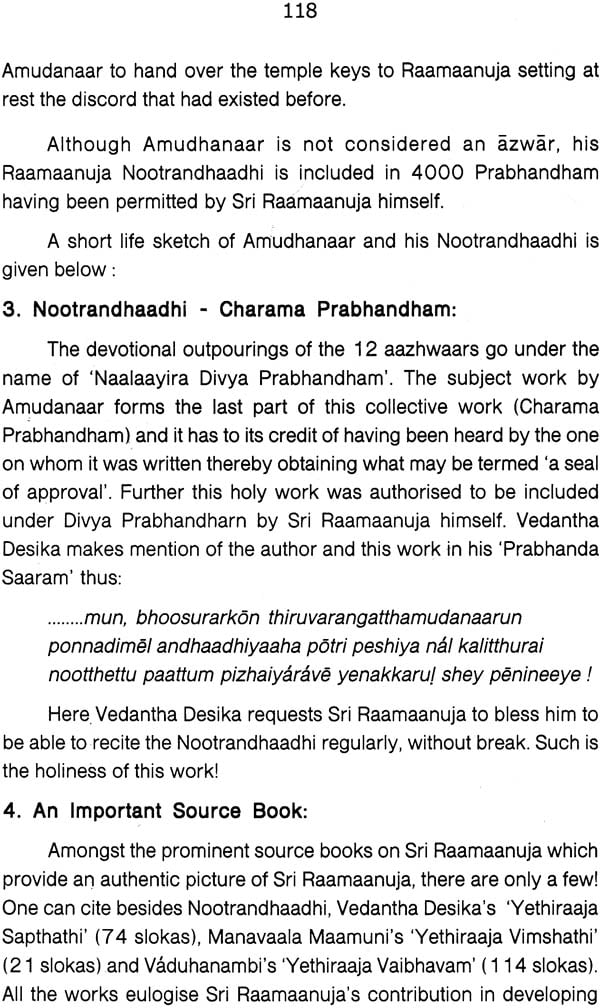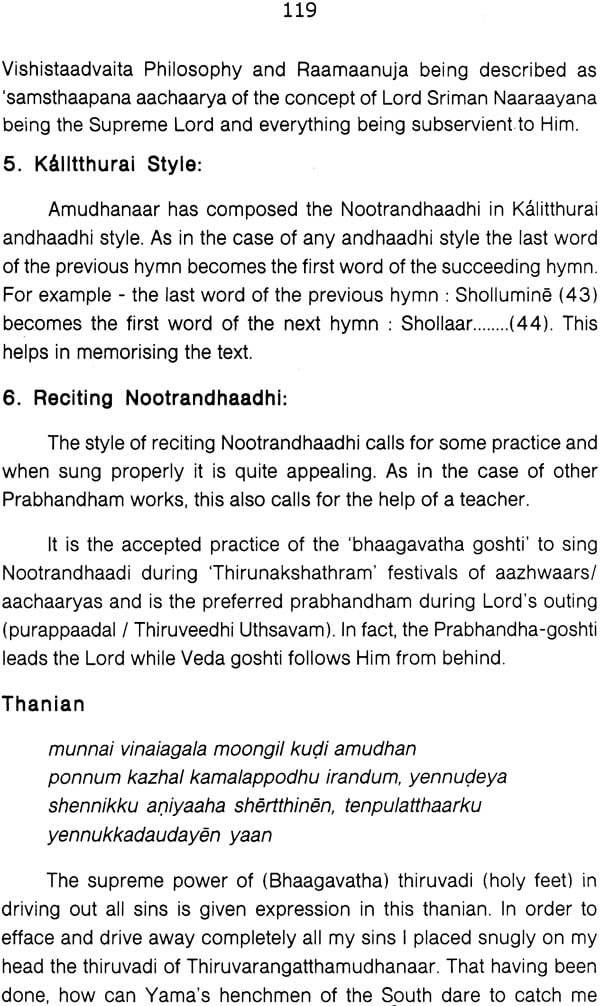
Azwars: The Divine Dozen
Book Specification
| Item Code: | NAM731 |
| Author: | K. R. Krishnaswami |
| Publisher: | A & K PRAKASHANA |
| Language: | English |
| Edition: | 2013 |
| Pages: | 124 |
| Cover: | Paperback |
| Other Details | 8.5 inch x 5.5 inch |
| Weight | 160 gm |
Book Description
Not long ago some readers had expressed that it would be useful to have an exclusive book chronicling the life and works of all azwars. Perceiving the merit in their observation, I have brought out this book. which I hope will be well received. The azwar. whom I call the 'divine dozen', are messengers of the Lord - some consider them to be extension of Lord's avataaras - conveying in their lyrical works Sriman Naaraayana's establishment in terms of creation etc., the mutual bond between soul and supreme soul (Jeevaathma-Paramaathma), interpretation of holy manthras like dvaya manthra ; and some of the works elicit the messages of the four Vedas. Azwar's works themselves are known as Tamil Vedas.
Adien has followed the course of presentation as per Veda nth a Desikar's Prabhandha saram. Thanians have been presented with meanings. Azwars' lives and works have been narrated in a synoptic manner.
I thank Mrs. Sudha for the DTP type setting, Sharada Prasad for timely printing (for release during Sri Nammaazwar Thirunakshathram) and Kiran for' an attractive cover design.
Like the upanishadhic seers, azwars experienced the Lord, Brahman, in their inner vision and by realizing Him demonstrated that Brahman who was philosophically the highest was also intuitionally loftiest - they delved deep into truths and expounded them to the common people. The spiritual experience of the azwars found expression in the form of hymns steeped in bhakthi, and collectively they are called the Naalaayira Divya Prabhandham.
The azwars are ten in number but with Sri Andal who descended to the Earth at Sri Villiputthoor in just the same way as Seethadevi, and counting Madurakavi azwar. the staunch devotee of Sri Nammazwar, the number goes up to twelve; Sri Andal in the only woman 8zwar amongst the dozen azwars. In this treatise Adiyen has attempted to present the lives of all the twelve azwars, along with their works covered in a synoptic manner.
Tamil Vedas : 4000 Divya Prabhandham
The spontaneous outpourings of the twelve azwars which are characterised by lyrical beauty and bhakthi are known as Prabhandham or Tamil Vedas. The hymns known as 'paasurams' in Tamil by the twelve azwars together total up to 4000 numbers and therefore they are termed as Nalayira Divya Prabhandham - 'divya' means divine or celestial and 'Prabhandham' means compositions.
Unlike the Sanskrit Vedas, Tamil Vedas or Prabhandham do not restrict the recitation to some only; all vernas and women are allowed to partake in learning and recitation. 4000 Divya Prabhandham is taught in religious institutions and temples in South India in particular. Rendering of a few hymns regularly during the 'shaartumurai' as a part of the 'aradhanarn' in temples and homes has been in vogue for centuries now; a minimum of two pasurams in the morning puja is compulsorily followed.
Lofty 'Azwar', defined in short !
An azwar is so called because he delved deep into divinity, that is, immersed as he was in divine thoughts and ennobled experiences, he let them pour over spontaneously in the form of hymns, rare lyrical psalms. They realised the Lord directly and left those experiences for posterity, inviting one and all to partake as it were in experiencing Lord's divine attributes, His sports, His leelas and broadly His mercy.
Azwars' 'Avataaras' Prophesied
Generally people talk of ten avataaras beginning with 'Mathsya' (these ten being 'vibhava' manifestations) and ending with 'Kalki'. But it is widely believed that God has not stopped appearing with just that. The ten avataaras, and another set of fourteen avataars of the Lord like Kapila, Prithu, Hamsa etc. are extension of His basic ten manifestations. There may be more to come!
The Bhagavatha Mahapurana by Veda Vyaasa had prophesied the birth of these azwars as follows:
"Kalaukalu bhavishyanthi paraayanaaha kwachith
kwachith mahaabhagaaha dramide shuscha bhsurishah
Taampraparni nadeeyatra krutamaala payaswinee
Kaaveri cha mahaabhaaga pratheecheecha Mahaanadhi //
The text means that the holy saints devoted to Sri man Naarayana would be born in Kaliyuga on the banks of the holy rivers of the Dravida land (near) Taampraparni, Kruthamaala (Vaigai), Payasvini (Papanaashini) and Cauvery rivers.
Fixing the age of Azwars
Traditionally our saints or rishis did not like to leave their personal traces excepting their experiences with the Lord or Vedanthic texts, as they attributed everything to the Lord Himself. Hence one has not paid heed to relate his name, period and contributions for posterity to connect.
The first three azwars, known as Mudhal azwars were born on consecutive days in 4200 BC. (Aippashimaasa thiruvonam ; Aippashimaasa avittam and thulaamaasa shadhaya) in the siddhaarthi samvathsara ; in the same samvathsara Thirumazishai azwar was also born ; Nammaazwar was born in 3101 BC (Vaikaashi vishaaka). Madhura Kavi azwar was born in 3222 BC in dwapara eon (thitthiyreyil shitthirai).
Kulashekara azwar was born in 3073 BC (maashi punar pooshattheyil) ; Peri azwar was born in 3054 BC (aanithannil perunjothi thanil) ; Sri Andal was born in 3003 BC (aadipooram) ; Thondaradippodi azwar was born in 2803 BC (maarghazimaadha kettei).
Thiruppaan Azwar was born in 2758 BC (Kaarthihei maadhatthil oorohininaal) ; Thirumangei azwar was born in 2702 BC (Kaarthiheiyil Kaarthikeinaal).
The period of birth shown above is as per 'sampradhaaya' determination (tradition). Modern researchers give different periods of birth : for e.g. Dr. N. Subha Reddiar places the date of birth of Nammazwar to 787 AD. The stars and months of birth as also the order of presentation are according to Swami Desikan's "Prabhandha Saaram". Only one azwar, Madura Kavi, is seen to have been born in 'dwaapara yuga'.
Azwar's Compositions :
'NALAYIRA DIVVA PRABANDHAM'
The term 'Nalayira' meaning 4000 is the total sum of hymns of twelve azwars : but the 24 compositions to which they belong falls short by 108 and with the consent of Sri Ramanuja, the 108 hymns in praise of himself by his contemporary known as Thiruvarangathamudhanaar go to complete the figure of 4000. Sri Vedantha Desikar follows this system of formation; Amudanaar is not an azwar, but an ardent devotee of Sri Ramanuja.
| Preface | iii | |
| Contents | iv | |
| Introduction | v | |
| Azwars - The Divine Dozen | 1 | |
| 1 | Poigai Azwars | 9 |
| 2 | Poodath Azwar | 13 |
| 3 | Pey Azwar | 16 |
| 4 | Thirumazishai Azwar | 18 |
| 5 | Thondaradippodi Azwar | 26 |
| 6 | Kulasekara Azwar | 33 |
| 7 | Tiruppaan Azwar | 39 |
| 8 | Thirumangai Azwar | 46 |
| 9 | Peri Azwar | 58 |
| 10 | Sri Azwar | 69 |
| 11 | Nammazwar | 94 |
| 12 | Madura Kavi Azwar | 94 |
| Thiruvarangath Amudhanaar | 117 |
